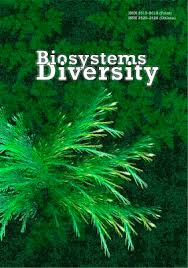Ecology of zoophilic flies in livestock biocenoses of Ukraine
Ecology of zoophilic flies in livestock biocenoses of Ukraine
Author(s): A. P. Paliy, A. N. Mashkey, L. I. Faly, O. S. Kysterna, A. P. Palii, H. I. RebenkoSubject(s): Agriculture, Physical Geopgraphy, Environmental Geography
Published by: Дніпропетровський національний університет імені Олеся Гончара
Keywords: zoophilic flies; species composition; Muscidae; cultivation; intraspecific; interspecific competition;
Summary/Abstract: In modern animal husbandry of Ukraine, there are still some unresolved issues related to the high number of zoophilic flies in the territories of facilities and the spread of animal infectious and parasitic diseases. A detailed study of bioecological peculiarities of the dominant zoophilic fly species contributes to improving the effectiveness of measures to control ectoparasites. 27 zoophilic fly species have been found in animal breeding complexes. The maximum number of parasitic Diptera species was recorded on cattle-keeping premises. The biological properties of Neomyia cornicina (Fabricius, 1781) (size, shape, colour, duration of preimaginal phase development) were studied. Also, we studied the dynamics of the number and daily activity of dominant fly species (Musca domestica Linnaeus, 1758, M. autumnalis De Geer, 1776, Stomoxys calcitrans (Linnaeus, 1758)). When studying the intraspecies competition, a high-degree survival of M. domestica and M. autumnalis was determined in the conditions of critical nutritional deficiency (0.5 g of nutrient medium per larva) and increased density of individuals (the imago emergence was 38.6% and 34.0%, respectively). In similar maintenance conditions, the emergence of N. cornicina imago was low (14.6%). With a two-fold increase in the insectarium volume and in the amount of nutrient medium (1 g per larva), the imago emergence of M. domestica, M. autumnalis and N. cornicina increased to 64.0%, 39.2%, and 24.0%, respectively. With an even greater increase in the amount of nutrient medium (2 g per larva), the maximum emergence of imagoes of all the studied fly species was observed (M. domestica, M. autumnalis, and N. cornicina: 96.6%, 91.2% and 72.6%, respectively). In the conditions of interspecific competition, M. autumnalis suppressed N. cornicina even in conditions of a sufficient amount of nutrient substrate. In the competition between M. domestica and M. autumnalis, house fly dominated. Increasing the nutrient medium volume narrowed the gap between the competing species.
Journal: Biosystems Diversity
- Issue Year: 29/2021
- Issue No: 3
- Page Range: 258-263
- Page Count: 6
- Language: English

